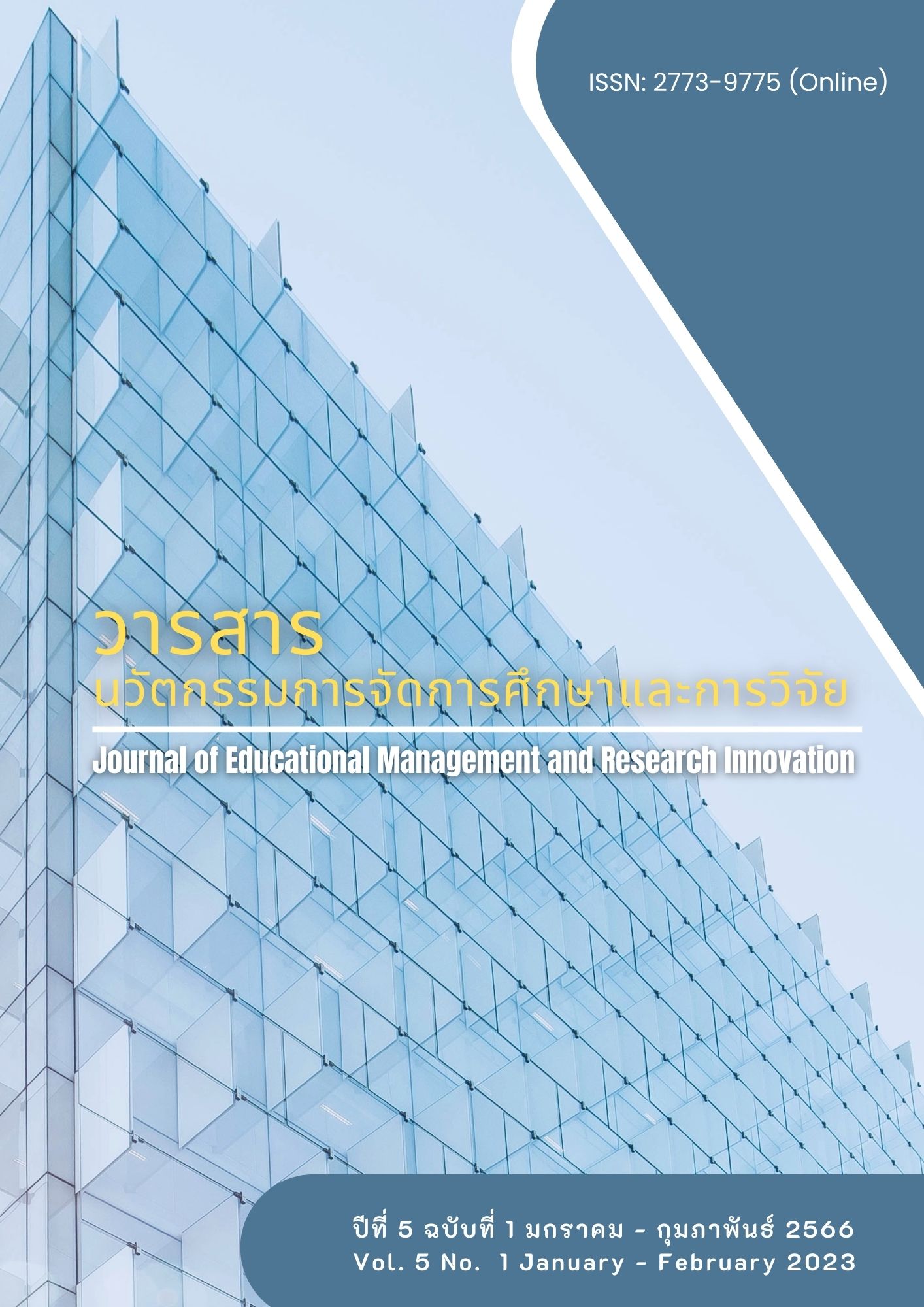โมเดลความสัมพันธ์เชิงสาเหตุของปัจจัยที่ส่งผลให้เกิดความตั้งใจซื้อสินค้าออนไลน์ของผู้บริโภคเจเนอเรชั่นเบบี้บูมเมอร์และเจเนอเรชั่นเอ็กซ์ เขตกรุงเทพมหานครและปริมณฑล
Main Article Content
บทคัดย่อ
บทความนี้มีวัตถุประสงค์เพื่อ 1) ศึกษาระดับการรับรู้ความเสี่ยง ความไว้วางใจ การรับรู้ประสิทธิภาพ ทัศนคติและความตั้งใจซื้อสินค้าออนไลน์ 2) ศึกษาอิทธิพลของการรับรู้ความเสี่ยง ความไว้วางใจที่มีต่อทัศนคติ และ 3) ศึกษาอิทธิพลของทัศนคติและการรับรู้ประสิทธิภาพที่มีต่อความตั้งใจซื้อสินค้าออนไลน์ รูปแบบการวิจัยเป็นการวิจัยเชิงปริมาณ กลุ่มตัวอย่าง คือ ผู้บริโภคเจเนอเรชั่นเบบี้บูมเมอร์และเจเนอเรชั่นเอ็กซ์ ที่ซื้อสินค้าออนไลน์ จำนวน 400 คน ในเขตกรุงเทพมหานครและปริมณฑล ใช้การเลือกตัวอย่างแบบโควต้า เครื่องมือที่ใช้ในการวิจัย คือ แบบสอบถามออนไลน์ วิเคราะห์ข้อมูลโดยใช้ ความถี่ ร้อยละ ค่าเฉลี่ย ส่วนเบี่ยงเบนมาตรฐาน และการวิเคราะห์สมการโครงสร้าง ผลการวิจัยพบว่า 1) ระดับการรับรู้ความเสี่ยง ความไว้วางใจ การรับรู้ประสิทธิภาพ ทัศนคติและความตั้งใจซื้อ ต่างอยู่ในระดับสูง 2)ตัวแปรการรับรู้ความเสี่ยงไม่มีอิทธิพลต่อทัศนคติในการซื้อสินค้าออนไลน์ ที่ระดับนัยสำคัญทางสถิติ 0.05 และตัวแปรความไว้วางใจมีอิทธิพลต่อทัศนคติในการซื้อสินค้าออนไลน์ ที่ระดับนัยสำคัญทางสถิติ 0.001 3) ตัวแปรทัศนคติในการซื้อสินค้าออนไลน์มีอิทธิพลต่อความตั้งใจซื้อสินค้าออนไลน์ ที่ระดับนัยสำคัญทางสถิติ 0.05 และตัวแปรการรับรู้ประสิทธิภาพมีอิทธิพลต่อความตั้งใจซื้อสินค้าออนไลน์ ที่ระดับนัยสำคัญทางสถิติ0.001
ข้อค้นพบจากงานวิจัยนี้ ผู้ประกอบการธุรกิจออนไลน์สามารถนำไปปรับใช้เพื่อสนับสนุนและพัฒนาร้านค้าได้ เนื่องจากผู้บริโภคให้ความสำคัญกับความไว้วางใจเป็นอย่างมาก และความไว้วางใจเป็นสิ่งสำคัญในการซื้อสินค้าออนไลน์ ทำให้ผู้บริโภคส่วนใหญ่เลือกซื้อสินค้าจากร้านค้าที่สามารถสร้างความไว้วางใจให้แก่ผู้บริโภคได้ หากผู้บริโภคเกิดความไว้วางใจจะทำให้เกิดความตั้งใจซื้อตามมา
Article Details

อนุญาตภายใต้เงื่อนไข Creative Commons Attribution-NonCommercial-NoDerivatives 4.0 International License.
เอกสารอ้างอิง
กัลยา วานิชย์บัญชา. (2557). การวิเคราะห์สมการโครงสร้างด้วย AMOS. (พิมพ์ครั้งที่ 3). กรุงเทพฯ: สามลดา.
พรนิภา หาญมะโน. (2558). พฤติกรรมการซื้อสินค้าของกลุ่ม Generation B Generation X และ Generation Y ที่ร้านค้าปลีกสมัยใหม่ในเขตอำเภอเมือง จังหวัดนครราชสีมา. Journal of Business Administration The Association of Private Higher Education Institutions of Thailand, 4(1), 54-75.
ภรันยา เปรมสวัสดิ์. (2562). ความไว้ใจ การรับรู้ด้านราคาและประสิทธิภาพของเว็บไซต์ที่ส่งผลต่อความตั้งใจซื้อสินค้าผ่านทางออนไลน์ จากห้างสรรพสินค้าที่มีชื่อเสียงโดยผู้ซื้อในเขตสาทร กรุงเทพมหานคร(วิทยานิพนธ์บริหารธุรกิจมหาบัณฑิต). มหาวิทยาลัยกรุงเทพ.
วิชญ์พล อุไรวรรณชัย. (2562). ทัศนคติของผู้ประกอบการธุรกิจขนาดกลางและย่อม (SMEs) ที่มีต่อการปฏิรูปดิจิทัล (Digital Transformation) ด้วยระบบบริหารจัดการผ่านเว็บไซต์สำหรับองค์กร (Web-Based Application)(วิทยานิพนธ์นิเทศศาสตร์มหาบัณฑิต). มหาวิทยาลัยกรุงเทพ.
ศิริลักษณ์ โรจนกิจอำนวย. (2561). ปัจจัยสำเร็จของพาณิชย์อิเล็กทรอนิกส์ข้ามพรมแดน. วารสารวิทยาลัยพาณิชยศาสตร์บูรพาปริทัศน์, 14(1), 30-43.
สำนักงานพัฒนาธุรกรรมทางอิเล็กทรอนิกส์. (15 ธันวาคม 2564). ผลสำรวจพฤติกรรมการใช้อินเตอร์เน็ตของคนไทยในปี 2564. สืบค้นเมื่อ 5 มกราคม 2565, จาก https://www.etda.or.th/th/pr-news/ETDA-released-IUB-2021.aspx.
สำนักงานสถิติแห่งชาติ กระทรวงดิจิทัลเพื่อเศรษฐกิจและสังคม. (2563). สรุปผลสำคัญ สำรวจการมีการใช้เทคโนโลยีสารสนเทศและการสื่อสารในครัวเรือน พ.ศ.2563. สืบค้นเมื่อ 5 มกราคม 2565, จาก http://www.nso.go.th/sites/2014/DocLib13/ด้านICT/.../2563/ Pocketbook63.pdf.
Ajzen, I., & Fishbein, M. (1975). A Bayesian analysis of attribution processes. Psychological bulletin, 82(2), 261-277.
Al-Debei, M. M., Akroush, M. N., & Ashouri, M. I. (2015). Consumer attitudes towards online shopping: the effects of trust, perceived benefits, and perceived web quality. Internet Research, 25(5), 707-733.
Bauer, R. A. (1960). Consumer behavior as risk taking. Paper presented at the Proceedings of the 43rd National Conference of the American Marketing Assocation, June 15, 16, 17, Chicago, Illinois.
Bolboaca, S.-D. & Jäntschi, L. (2006). Pearson versus Spearman, Kendall’s tau correlation analysis on structure-activity relationships of biologic active compounds. Leonardo Journal of Sciences, 5(9), 179-200.
Boshoff, C., Schlechter, C. & Ward, S. J. (2011). Consumers' perceived risks associated with purchasing on a branded web site: The mediating effect of brand knowledge. South African Journal of Business Management, 42(1), 45-54.
Cheung, M. F. Y. & To, W. M. (2017). The influence of the propensity to trust on mobile users' attitudes toward in-app advertisements: An extension of the theory of planned behavior. Computers in human behavior, 76, 102-111.
Davis, F. D., Bagozzi, R. P. & Warshaw, P. R. (1989). User acceptance of computer technology: A comparison of two theoretical models. Management science, 35(8), 982-1003.
DeLone, W. H. & McLean, E. R. (2003). The DeLone and McLean model of information systems success: a ten-year update. Journal of management information systems, 19(4), 9-30.
Di Pietro, L., Di Virgilio, F. & Pantano, E. (2012). Social network for the choice of tourist destination: attitude and behavioural intention. Journal of Hospitality and Tourism Technology, 3(1), 60-67.
Howard, J. A., & Sheth, J. N. (1969). The theory of buyer behavior. New York, 63, 145.
Marza, S., Idris, I. & Abror, A. (2018). The Influence of Convenience, Enjoyment, Perceived Risk, and Trust on the Attitude of Padang State University Students Towards Online Shopping. Paper presented at the The 2nd Padang International Conference On Education, Economics, Business And Accounting (THE 2nd PICEEBA 2018).
Morgan, R. M. & Hunt, S. D. (1994). The commitment-trust theory of relationship marketing. Journal of marketing, 58(3), 20-38.
Nunnally, J. & Bernstein, I. (1994). Psychometric Theory. New York: MacGrow-Hill Higher.
Rojas, A. J., Fernández, J. S. & Pérez, C. (2000). Investigar mediante encuestas Fundamentos teóricos y aspectos prácticos. Psicothema, 320-323.
Sin, S. S., Nor, K. M. & Al-Agaga, A. M. (2012). Factors Affecting Malaysian young consumers’ online purchase intention in social media websites. Procedia-Social and Behavioral Sciences, 40, 326-333.
Stern, S. (1997). Approximate solutions to stochastic dynamic programs. Economietic Theroy, 13(3), 392-405.
Stone, R. N. & Gronhaug, K. (1993). Perceived risk: Further considerations for the marketing discipline. European Journal of marketing, 27(3), 39-50.
Suleman, D. (2019). Perceived ease of use, trust and risk toward attitude and intention in shopping for online fashion products in Indonesia. Archives of Business Research, 7(4).
Williams, K. C., Hernandez, E. H., Petrosky, A. R. & Page, R. A. (2009). Fine-tuning useful E-commerce practices. Journal of Technology Research, 1, 1.
Yuan, K. H., Wu, R. & Bentler, P. M. (2011). Ridge structural equation modeling with correlation matrices for ordinal and continuous data. British Journal of Mathematical and Statistical Psychology, 64(1), 107-133.
Zhang, B. & Kim, J.-H. (2013). Luxury fashion consumption in China: Factors affecting attitude and purchase intent. Journal of Retailing and Consumer Services, 20(1), 68-79.


